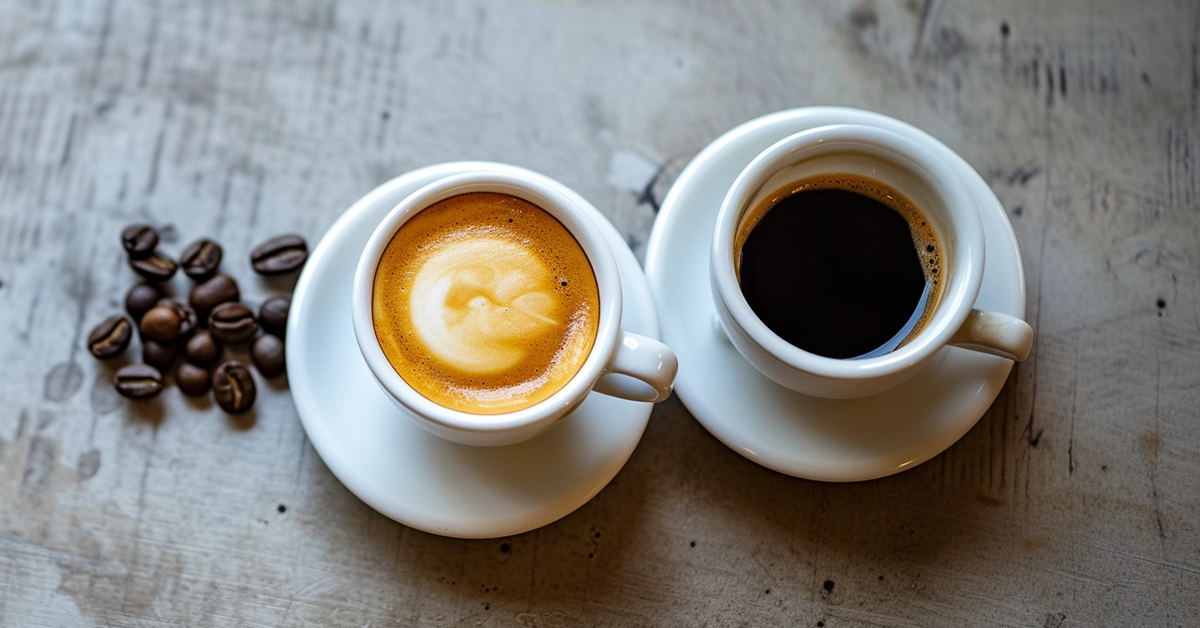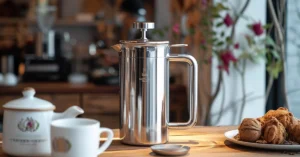When it comes to coffee, the debate between espresso vs macchiato often leaves many scratching their heads. What’s the real difference? Simply put, an espresso is a strong, concentrated coffee shot, celebrated for its bold flavor and velvety crema on top. A macchiato, on the other hand, takes this intense base and adds a dollop of steamed milk to it, creating a balance that softens the espresso’s edge.
Think of espresso as that punchy, energetic friend who dives straight into adventure. Macchiato is more like the friend who brings along a snack, just in case. Whether you crave the unadulterated strength of espresso or the nuanced, creamy touch of a macchiato, understanding these two can elevate your coffee game.
Let’s dive deeper into what sets them apart and maybe help you decide on your next coffee order.
The Foundation of Both Beverages: Espresso
Espresso is a concentrated shot of coffee originating from Italy, known for its bold flavor and distinctive crema. It’s created using an espresso machine that applies high pressure to finely-ground coffee.
Origins of Espresso
The tradition of espresso began in Italy, a country that prides itself on its rich coffee culture. Espresso was an answer to the quest for quick, strong coffee. In the early 20th century, the first espresso machines were introduced, transforming how coffee was made and enjoyed by allowing for the quick preparation of a bold coffee.
Espresso Machine Basics
An espresso machine is your quintessential tool for making espresso. It works by forcing high pressure water through finely-ground coffee to extract a concentrated shot of coffee. The core elements of an espresso machine include a portafilter to hold the coffee grounds, a boiler to heat water, a pump to create pressure, and a group head where water meets coffee.
The Espresso Brewing Process
The brewing process of an espresso starts with grinding coffee to a fine consistency. Then, you’ll tamp the grounds into the portafilter, ensuring an even surface for water to pass through. The machine then pushes hot water through the coffee at 9 bars of pressure, a process taking about 25-30 seconds. The result is a rich, bold coffee characterized by espresso flavor and a layer of crema on top—essentially a small yet potent concentrated shot of coffee.
Pros
- Quality Extraction: Features a 20-bar professional Italian pump and a powerful 1350W boiler for top-quality extraction and rich aroma.
- Pressure Control: Equipped with a built-in pressure gauge to customize your coffee based on personal taste preferences.
- Steam Wand: The powerful steam wand enables the creation of creamy, rich microfoam milk for latte art and flavor enhancement.
Cons
- Cool Down Period: You cannot brew coffee immediately after frothing milk, as the machine needs to cool down to avoid over-heating protection mode.
- Noise Level: Some users may find the machine a bit noisy during operation.
Add Milk to Espresso: Macchiato

History and Variation
Macchiato, meaning “marked” or “stained” in Italian, traditionally refers to an espresso “marked” with a spot of milk. The Caffè Macchiato and Latte Macchiato are two main variants, anchoring a long history of Italian espresso culture. The Caffè Macchiato offers the robust flavor of espresso with just a dash of milk, while the Latte Macchiato, a milk-heavy version, typically involves a larger amount of steamed milk stained by a shot of espresso.
Macchiato Preparation Methods
The Espresso Macchiato preparation starts with a high-quality espresso shot. For the finishing touch, steamed milk is added. In contrast, the Latte Macchiato involves gently pouring espresso over a sizable amount of foamy milk, leading to a layered visual and taste experience.
- Caffè Macchiato: 1 shot of espresso + steamed milk
- Latte Macchiato: Steamed milk + milk foam, followed by 1 shot of espresso
Traditional vs. modern variations of macchiato
While traditional macchiatos are relatively simple, modern coffee culture has warmly embraced inventive takes on this classic. The Caramel Macchiato, which layers vanilla-flavored syrup, steamed milk, espresso, and a rich drizzle of caramel sauce, is a testimony to contemporary tastes. From the sweet concoctions at chain coffee shops to the latest Cloud Macchiato, featuring a fluffy cap of milk foam and often sweetened with caramel or other flavored syrups, the macchiato has proven to be a versatile canvas for creativity.
Comparing Espresso and Macchiato

Differences in Ingredients
Espresso is the foundation for both drinks, originating from Italy as a concentrated coffee brewed by forcing steam through finely-ground coffee beans. A macchiato, which means “stained” or “spotted” in Italian, is essentially an espresso with a spot of milk foam on top. Unlike more milk-heavy counterparts, the macchiato uses a minimal amount of milk, just enough to ‘stain’ the espresso.
Contrasting Flavor Profiles
When it comes to taste, an espresso offers a potent and pure coffee experience with a strong flavor due to the high coffee-to-water ratio. A macchiato softens this intensity with the milk foam, which adds a slight richness and creaminess, altering the flavor profile just enough to make it less bracing while still retaining a strong coffee essence.
Beverage Presentation and Serving Size
Presentation sets these two apart as well. Espresso is typically served in a small cup, often a demitasse, with a capacity of about 1 oz (approximately 30ml). Macchiatos come in slightly larger servings due to the addition of foam. The serving size can vary, but a traditional macchiato is often presented in a 2 oz to 3 oz serving. The layered drink aspect, with the distinct separation of the dark coffee below the light foam, is a visual hallmark of the cafe macchiato.
The Role of Milk in Espresso and Macchiato
When you’re distinguishing between an espresso and a macchiato, milk is the defining ingredient. Its preparation and addition transform the bold espresso into the milder macchiato.
Frothed and Steamed Milk Techniques
Steamed Milk: For your macchiato, steamed milk is key. It’s typically heated to around 150-160 degrees Fahrenheit. This not only warms the milk but creates a velvety microfoam that’s essential for that creamy texture.
- How to Steam Milk:
- Pour cold milk into a pitcher no more than halfway full.
- Hold the steamer just below the surface to create microfoam with tiny, uniform bubbles.
- Heat until the pitcher feels hot to the touch.
Foamed Milk: Unlike steamed milk, foamed milk has larger bubbles and a more airy texture. It serves as the “stain” or mark on an espresso to create the traditional macchiato.
- How to Foam Milk:
- Use either a hand frother or the steam wand of an espresso machine.
- Introduce more air by keeping the tip of the wand closer to the milk’s surface.
- Continue until you get a froth with the volume and consistency you desire.
Milk Varieties and Textures
Different types of milk affect the flavor and texture of your espresso or macchiato. Whole milk is a popular choice because it creates a creamier, richer microfoam.
- Types of Milk to Consider:
- Whole Milk: Offers a balance of fat, sweetness, and creamy texture.
- Skim Milk: Less creamy, with stiffer foam due to the higher protein content.
- Plant-Based Alternatives: Soy, almond, or oat milk can also be used but may require different techniques to achieve the right texture.
For a macchiato, you’ll typically want a small dollop of milk—steamed or frothed—to add to the espresso.
Creative Additions to Espresso and Macchiato
Elevating your espresso or macchiato from ordinary to extraordinary is all about the creative touches you add. Whether it’s through unique flavors or visually appealing latte art, these enhancements can transform your coffee experience.
Flavors Beyond the Basics
If you’re looking to infuse a new twist into your espresso or macchiato, consider experimenting with a variety of flavored syrups. Here are some popular choices and how you can integrate them:
- Caramel: Add a smooth, sweet note to your macchiato with a drizzle of caramel syrup. For an espresso, a splash can complement its natural robustness.
- Chocolate: Chocolate syrup can turn a standard macchiato into a mocha-inspired treat, especially when paired with steamed milk.
- Vanilla syrup: A shot of vanilla syrup will sweeten your espresso without overpowering it, giving a classic flavor a fresh spin.
Feel free to mix flavors for your own signature drink, such as combining chocolate and caramel for a decadent duo.
Artistic Touches to Coffee Service
Your macchiato or espresso can become a canvas for creativity with latte art. Here’s how to add an artistic touch:
- Start simple: Begin with basic shapes, like a heart or a rosetta, made by pouring steamed milk into your espresso.
- Practice: The key to perfecting latte art is consistent practice, so don’t be discouraged if your first attempts are not masterpieces.
- Get equipped: Use a narrow spout pitcher for more control and a fine-point barista tool for intricate designs.
Remember, latte art requires patience and a steady hand, but it’s a satisfying way to personalize your coffee.
Types of Espresso and Macchiato Drinks
Espresso and macchiato both enjoy a rich variety of interpretations, from timeless classics that honor traditional Italian coffee culture to innovative modern recipes that add a twist to these beloved beverages.
Classic Variations
Espresso is the foundation of many popular coffee drinks. It’s a strong, concentrated coffee, typically served in a small cup with a thick layer of crema.
- Macchiato: A shot of espresso with a dollop of frothed milk, traditionally “staining” the coffee.
- Latte: A creamy drink made with one-third espresso, two-thirds steamed milk, and usually a light layer of foam.
- Cappuccino: Similar to a latte but with equal parts espresso, steamed milk, and milk foam, often sprinkled with chocolate or cinnamon.
- Flat White: This Australian favorite contains a double shot of espresso topped with microfoam, a velvety and smooth type of steamed milk.
- Mocha: A latte with chocolate syrup or cocoa powder, combining the bold flavors of espresso with the richness of chocolate.
- Cortado: A balanced beverage with equal amounts of espresso and warm milk to reduce the acidity.
- Americano: Made by diluting a shot of espresso with hot water, resulting in a strength akin to drip coffee but with an espresso’s flavor.
💡Did you know this?
There is an alternative to espresso: Explore our guide on How to make Double Brewed Coffee.
FAQ – Espresso vs Macchiato
Is A Macchiato Stronger Than an Espresso?
Yes, a macchiato is typically stronger than a plain espresso due to its smaller volume of milk which does little to dilute the strong coffee flavor of the espresso base.
What is the Difference Between Shaken Espresso and Macchiato?
Shaken espresso combines espresso with ice and sometimes syrup or other flavors, which is then shaken vigorously and strained into a glass. A macchiato, on the other hand, is simply an espresso with a small amount of milk added to it.
What is the Difference Between Short Macchiato and Espresso?
A short macchiato has a dollop of steamed milk and foam added to a single shot of espresso, which results in a layered drink that’s slightly milder than a straight espresso.
What is an Espresso With Milk Called?
An espresso with milk can go by different names depending on the amount and form of milk added. For example, a small amount of milk added to an espresso is called a macchiato, whereas more milk would make it a cappuccino or a latte.
If you liked our blog post on the topic “Espresso vs Macchiato”, don’t forget to leave us a comment down and share your thoughts on this topic.





